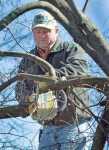Post-ice storms: To save a tree or not to save a tree?

SIKESTON -- Two ice storms within about a week's time damaged the tree population by splintering and uprooting several species throughout the region.
Now homeowners and plant experts are surveying their wounded trees and wondering whether to prune or replant. Over the past few days David Bizzell, owner of Bizzell Nursery Co. in Sikeston, has been conducting tree health evaluations at the request of others. "The trees that we go look at -- most can be pruned and overcome the damage in a couple years. A very small percentage of the trees have been removed," Bizzell said. White pines, river birches and oaks are among local trees that sustained the most damage, Bizzell said. "It was really a strange storm (the first time)," Bizzell said. "We had some oaks that were broken where squirrels stripped the bark and caused cankers."
Bizzell noted trees were already hurt this past year due to last spring's early freeze and the drought late in the summer.
"Any time you get wood where it's very dry and doesn't have the moisture content, it will be more brittle," Bizzell said. And, of course, some limbs broke simply because the load of ice was too heavy to hold, Bizzell said. "It seems like the hardest hit trees are the faster-growing, more brittle wooded trees such as ornamental pears and soft maples. Damage wasn't limited to those but they seem to be some of the most common trees hit," said Donna Aufdenburg, University of Missouri Extension horticulture specialist for the Southeast Missouri region. Of the trees that have been saved -- and can be saved -- proper pruning, or cutting limbs at branch collars (where the branch meets the tree trunk), is instrumental in their continued growth, Bizzell said. Also making sure limbs rubbing together are removed is key, he said. "Now is a good time to be pruning because tree wounds will heal faster now than they would while the leaves are on them," Aufdenburg said.
Before even walking under damaged trees, know what's broke and hanging, Bizzell said. If limbs are hanging in a tree, call a tree company or service to remove them, he said. Once a tree has been inspected, limbs can be removed. "It's a very dangerous situation (to cut tree limbs), and you can be hurt so fast. That tree can splinter or kick back or break and knock you with it,"said Bizzell, who is considering offering a pruning basics course for the public in the near future. It's always important to remove branches that may be a potential hazard in the future or limbs that are half-attached or dying, Aufdenburg said.
Both Bizzell and Aufdenburg said there's no need to use pruning paints because they can lock in moisture and pathogens, which can cause diseases. "A final cut should be a collar cut made at a 45-degree angle. That way it sheds the water and dries faster," Aufdenburg said. Tree fertility is also important, Bizzell said. "This is a good time to fertilize trees," Bizzell said, adding the fertilizer helps trees build up nutrient reserves.
Ways to tell that a tree is beyond repair are if the tree is coming out of its root system, the majority of the foliage and limbs have been broken, the trunk is splitting, the tree is unsafe or its ability to photosynthesize is no longer existent, Bizzell said. If a tree is dead, replacements can be planted. But Aufdenburg suggested buyers do their homework first.
"As long as the ground is not frozen, trees can be planted," Aufdenburg said. However, fall is the best, and spring is the second best, Aufdenburg said. The earlier (a tree is planted before hot weather arrives), the better, she said. "That way it gets in the ground and its roots established," Aufdenburg said. For those unsure of which tree might work best, look around the neighborhood to see which trees survived well, Aufdenburg said. "Know your goal. Do you want the tree for shade, for spring flowers or fall colors? Gear your tree choice by your responses," Aufdenburg said.
If replacing trees, owners should consider the maximum height of the tree at maturity, Aufdenburg said.
"When you look for one, pay attention to how big it will get and how fast it grows," Aufdenburg said. "... Stronger trees are slower growing trees. If you want something to grow fast, they will break the same as some of the ornamental pears and maples did." Planting trees in the wrong location can have consequences, Aufdenburg said. "If the tree was under electric lines before, maybe try to avoid putting it under electric lines thistime," Aufdenburg said.
Some people like to plant trees too close to their house, but Aufdenburg advised planting no closer than 20 feet to the house.
"That way if another wind or ice storm comes, it might clear the house," Aufdenburg said.
Preparing better for the next storm -- no matter what the season -- is all anyone can do, Aufdenburg said.
"I don't put anything past Mother Nature," Aufdenburg said, "because I think she surprises us all the time."

